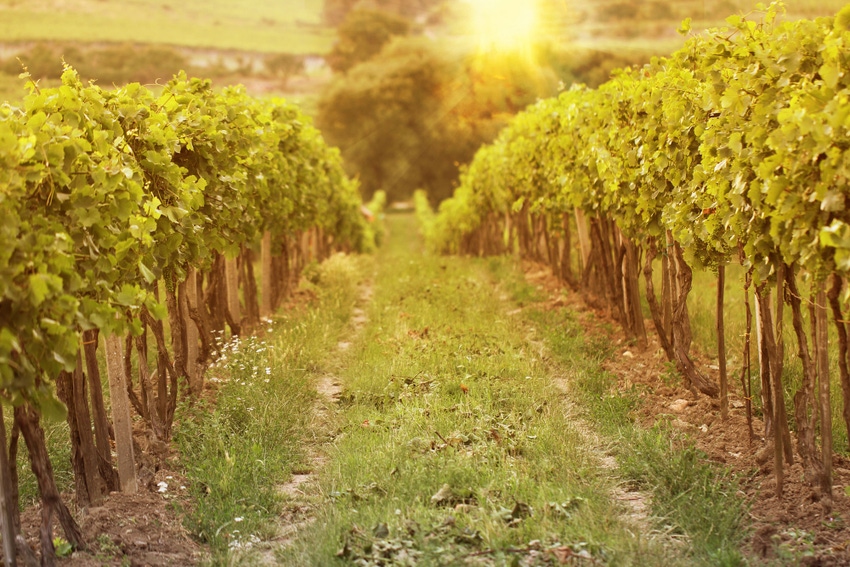
Following the unusually wet winter weather and warm spring temperatures, flourishing stands of barley, mustard and other cover crops were a common sight in between the rows in San Joaquin Valley vineyards earlier this spring.
But so, too, were weed species, which also took advantage of the favorable weather and soil conditions to thrive in some of these same inter-row areas.
In many cases, these weed species, mostly volunteer winter annuals, covered these areas uniformly. “They behaved much like a mix of desirable species planted as a cover crop,” says Lindsay Jordan, University of California Cooperative Extension advisor for Madera, Merced and Mariposa
A vineyard can benefit in many ways from a robust, intentionally-seeded cover crop, she said. The fibrous root systems of winter cereals can break up compacted soils, while legumes can fix nitrogen and contribute to vine nutrition. All cover crop plant species can be used to protect the soil surface from erosion and crusting, improve water infiltration and provide structure-building organic matter to the soil when mowed or cultivated. A cover crop of weeds could, potentially, do the same thing.
That’s led some growers to ask: “Does it really matter if the vineyard floor cover is resident vegetation – a polite term for weeds – or a seeded cover crop?”
She takes up that question in the Spring issue of Vit Tips, UCCE‘s San Joaquin Valley viticulture newsletter.
A cover crop can be managed to out-compete and shade-out early season weed pressure in vineyard inter-rows. In one field mowed this spring, a vigorous barley cover crop successfully kept other competing weed species from establishing, she said.
In another vineyard, some rows were seeded with barley this winter, while others were seeded in the previous year and allowed to naturally reseed and emerge this season. This also allowed any resident vegetation to emerge.
The biggest difference between the two cover crop stands was the presence of weeds, she notes. In the self-reseeded stand, from 25 percent to 50 percent of the rows were actually covered by species other than the barley, most predominately filarees (Erodium spp.) and cheeseweed (Malva parviflora).”
“The risks of allowing resident vegetation to establish must be weighed against the saved expense in time and materials of not controlling these weeds just for the current season, but also their impact on your vineyard floor management in years to come,” Jordan says.
She explains the consequences of allowing a stand of resident vegetation to turn into an aggressive weed infestation:
Some species of weeds will always be undesirable.
Some species of plants will never be an innocuous part of a cover crop mix, Jordan notes. Species like yellow starthistle (Centaurea solstitialis) or stinging and burning nettles can pose a risk to worker safety, and any herbicide resistant weeds, like the glyphosate resistant horseweed (Conyza canadensis) that appear in San Joaquin Valley vineyards, pose a large risk to future vineyard production operations.
“Some weed species should not be tolerated as part of a cover crop mix,” she says.
Weed species may spread.
Weed species that are intentionally allowed to grow in the vineyard inter-rows may not stay confined to that area. If they spread to the under-vine rows or other parts of the vineyard, additional weed control may be required that season.
Weeds are contributing to the seed bank.
Some weed species may have gone to seed by the time you mow or cultivate your vineyard floor cover. Those seeds are now permanently added to your seed bank and may affect future years' weed pressure.
Weeds may compete with vines.
You cannot select which resident vegetation species will establish in your vineyard, Jordan says. Using purchased cover crop seed allows you to time your vineyard floor management according to the cover crop’s known lifecycle, so that it complements your cropping production system. However, there’s no guarantee that weed species won’t be growing actively and competing with vines for water and/or nutrients during critical times of the growing season.
“To judge when resident vegetation has morphed into a deleterious weed population, you need to know exactly which resident vegetation species are present and their stage of growth,” Jordan says. “Proper identification of weed species within a specific field site is critical before letting resident vegetation species mature with or instead of a cover crop. Once you understand the risks of your specific weed population at a vineyard site, you can consider whether the use of a resident vegetation cover can be incorporated into your vineyard floor management. “
About the Author(s)
You May Also Like




